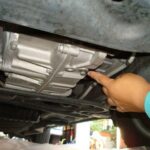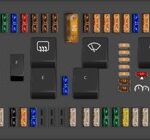The Ford Passive Anti-Theft System (PATS) is designed to prevent vehicle theft, but it can sometimes cause starting problems. Before considering disabling PATS Ford systems, troubleshooting the issue is crucial. A common cause of PATS malfunction in Ford vehicles, particularly in SN95 Mustangs (1994-2004), is a faulty transceiver wiring harness. This article will discuss diagnosing and fixing this common problem, offering a potential solution before resorting to disabling the system.
Common PATS Issues in Ford Vehicles
A frequent symptom of PATS trouble is an intermittent no-start condition. The theft light on the dashboard might flash rapidly while the engine cranks but fails to start. This often indicates a problem with the communication between the transceiver, located around the steering column, and the vehicle’s computer. In SN95 Mustangs, repeated use of the tilt steering wheel function can contribute to this issue.
The constant up-and-down movement of the steering wheel stresses the delicate transceiver wires at the connector point under the dashboard. Over time, these small gauge wires can break, leading to intermittent or complete loss of communication, triggering the PATS system and preventing the engine from starting.
Troubleshooting the Transceiver Wiring
If you’re experiencing PATS-related starting problems in your Ford, especially an SN95 Mustang, carefully inspect the transceiver wiring harness. Begin by visually examining the white connector that attaches the transceiver harness to the main wiring harness under the dash. Look for any signs of damage, such as broken or frayed wires, loose connections, or corrosion.
In some cases, manipulating the steering wheel position might temporarily restore the connection and allow the car to start. This can be a key indicator of a wiring issue within the transceiver harness.
Repairing the Transceiver Wiring
If a damaged wire is found, repair is often possible. Accessing the connector can be challenging, requiring careful removal of surrounding components. Once accessible, the damaged wires can be repaired by soldering the broken connections. This requires opening the crimped connectors, which can be delicate work. If a replacement transceiver wiring harness is available from Ford at a reasonable price, replacement is the preferred option. After repairing or replacing the harness, consider unclipping it from its original position on the dash to reduce stress on the wires during steering wheel adjustments.
Conclusion: Fix It, Don’t Disable It
Disabling PATS Ford systems should be a last resort. In many cases, PATS issues, particularly in SN95 Mustangs, stem from a damaged transceiver wiring harness. By carefully inspecting and repairing this harness, you can often resolve the problem without compromising your vehicle’s anti-theft protection. Remember, proper diagnosis and repair are crucial before considering more drastic measures like disabling a critical security system. If you are unsure about performing this repair yourself, consult a qualified automotive technician.


